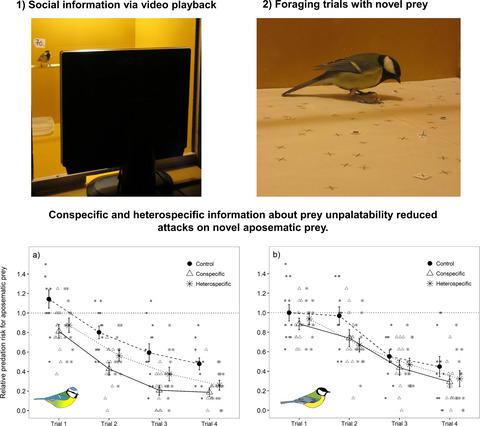当前位置:
X-MOL 学术
›
J. Anim. Ecol.
›
论文详情
Our official English website, www.x-mol.net, welcomes your feedback! (Note: you will need to create a separate account there.)
Social learning within and across predator species reduces attacks on novel aposematic prey
Journal of Animal Ecology ( IF 4.8 ) Pub Date : 2020-02-19 , DOI: 10.1111/1365-2656.13180 Liisa Hämäläinen 1 , Johanna Mappes 2 , Hannah M Rowland 1, 3, 4 , Marianne Teichmann 5, 6, 7 , Rose Thorogood 1, 5, 6
Journal of Animal Ecology ( IF 4.8 ) Pub Date : 2020-02-19 , DOI: 10.1111/1365-2656.13180 Liisa Hämäläinen 1 , Johanna Mappes 2 , Hannah M Rowland 1, 3, 4 , Marianne Teichmann 5, 6, 7 , Rose Thorogood 1, 5, 6
Affiliation

|
Abstract To make adaptive foraging decisions, predators need to gather information about the profitability of prey. As well as learning from prey encounters, recent studies show that predators can learn about prey defences by observing the negative foraging experiences of conspecifics. However, predator communities are complex. While observing heterospecifics may increase learning opportunities, we know little about how social information use varies across predator species. Social transmission of avoidance among predators also has potential consequences for defended prey. Conspicuous aposematic prey are assumed to be an easy target for naïve predators, but this cost may be reduced if multiple predators learn by observing single predation events. Heterospecific information use by predators might further benefit aposematic prey, but this remains untested. Here we test conspecific and heterospecific information use across a predator community with wild‐caught blue tits (Cyanistes caeruleus) and great tits (Parus major). We used video playback to manipulate social information about novel aposematic prey and then compared birds’ foraging choices in ‘a small‐scale novel world’ that contained novel palatable and aposematic prey items. We expected that blue tits would be less likely to use social information compared to great tits. However, we found that both blue tits and great tits consumed fewer aposematic prey after observing a negative foraging experience of a demonstrator. In fact, this effect was stronger in blue tits compared to great tits. Interestingly, blue tits also learned more efficiently from watching conspecifics, whereas great tits learned similarly regardless of the demonstrator species. Together, our results indicate that social transmission about novel aposematic prey occurs in multiple predator species and across species boundaries. This supports the idea that social interactions among predators can reduce attacks on aposematic prey and therefore influence selection for prey defences.
中文翻译:

捕食者物种内部和之间的社会学习减少了对新型隐匿猎物的攻击
摘要 为了做出适应性觅食决策,捕食者需要收集有关猎物盈利能力的信息。除了从猎物遭遇中学习外,最近的研究表明,捕食者可以通过观察同种动物的负面觅食经历来了解猎物的防御能力。然而,捕食者社区是复杂的。虽然观察异种物种可能会增加学习机会,但我们对不同捕食者物种的社会信息使用有何不同知之甚少。捕食者之间回避的社会传播也对受保护的猎物有潜在的影响。显眼的隐喻猎物被认为是天真的捕食者的一个容易目标,但如果多个捕食者通过观察单个捕食事件来学习,这种成本可能会降低。捕食者对异种信息的使用可能会进一步使隐性猎物受益,但这仍然未经测试。在这里,我们测试了捕食者群落中的同种和异种信息使用情况,其中包括野生捕捞的蓝山雀(Cyanistes caeruleus)和大山雀(Parus major)。我们使用视频播放来操纵有关新型隐匿猎物的社会信息,然后比较鸟类在包含新奇可口和隐匿猎物的“小规模小说世界”中的觅食选择。我们预计与大山雀相比,蓝山雀不太可能使用社交信息。然而,我们发现在观察到示威者的负面觅食经历后,蓝山雀和大山雀消耗的猎物都较少。事实上,与大山雀相比,蓝山雀的这种效果更强。有趣的是,蓝山雀也可以通过观察同种动物来更有效地学习,而不管演示者的物种如何,大山雀的学习方式都相似。总之,我们的结果表明,关于新的隐匿猎物的社会传播发生在多个捕食者物种中并跨越物种边界。这支持了捕食者之间的社会互动可以减少对隐蔽猎物的攻击,从而影响对猎物防御的选择的想法。
更新日期:2020-02-19
中文翻译:

捕食者物种内部和之间的社会学习减少了对新型隐匿猎物的攻击
摘要 为了做出适应性觅食决策,捕食者需要收集有关猎物盈利能力的信息。除了从猎物遭遇中学习外,最近的研究表明,捕食者可以通过观察同种动物的负面觅食经历来了解猎物的防御能力。然而,捕食者社区是复杂的。虽然观察异种物种可能会增加学习机会,但我们对不同捕食者物种的社会信息使用有何不同知之甚少。捕食者之间回避的社会传播也对受保护的猎物有潜在的影响。显眼的隐喻猎物被认为是天真的捕食者的一个容易目标,但如果多个捕食者通过观察单个捕食事件来学习,这种成本可能会降低。捕食者对异种信息的使用可能会进一步使隐性猎物受益,但这仍然未经测试。在这里,我们测试了捕食者群落中的同种和异种信息使用情况,其中包括野生捕捞的蓝山雀(Cyanistes caeruleus)和大山雀(Parus major)。我们使用视频播放来操纵有关新型隐匿猎物的社会信息,然后比较鸟类在包含新奇可口和隐匿猎物的“小规模小说世界”中的觅食选择。我们预计与大山雀相比,蓝山雀不太可能使用社交信息。然而,我们发现在观察到示威者的负面觅食经历后,蓝山雀和大山雀消耗的猎物都较少。事实上,与大山雀相比,蓝山雀的这种效果更强。有趣的是,蓝山雀也可以通过观察同种动物来更有效地学习,而不管演示者的物种如何,大山雀的学习方式都相似。总之,我们的结果表明,关于新的隐匿猎物的社会传播发生在多个捕食者物种中并跨越物种边界。这支持了捕食者之间的社会互动可以减少对隐蔽猎物的攻击,从而影响对猎物防御的选择的想法。


























 京公网安备 11010802027423号
京公网安备 11010802027423号